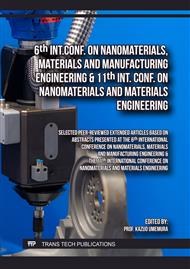p.23
p.31
p.41
p.51
p.57
p.63
p.71
p.81
p.87
Blend Optimization of Gum Arabic/Citric Acid Bioadhesive for Wound Dressing Applications
Abstract:
Bioadhesives provide a good alternative to traditional wound treatment for developing liquid bandages or self-adhesive wound dressings. In this study, a bioadhesive is developed by blending locally available gum arabic (Gum) and citric acid (CA), and the Gum-CA blending formulation is optimized based on different properties: drying rate, swelling capacity, and hydrophilicity. A regression model based on the desirability function approach was derived from the obtained experimental data to determine the optimum blend ratio, which is then used to synthesize a Gum-CA blend to validate the model. Results show that the optimal Gum-CA blend fraction ratio is 0.5131/0.4869 with an ideal drying rate of 0.0051 g/min, a swelling capacity of 101.53%, and a water contact angle of 54.76°. It was also observed that the blending ratio is directly proportional to the drying rate and swelling capacity and inversely proportional to the water contact angle. Moreover, the regression model validation shows that all the models overestimate the data sets for the parametric analysis and validation experiments.
Info:
Periodical:
Pages:
57-62
Citation:
Online since:
June 2025
Authors:
Keywords:
Price:
Сopyright:
© 2025 Trans Tech Publications Ltd. All Rights Reserved
Share:
Citation:



